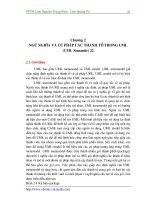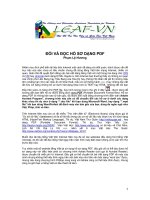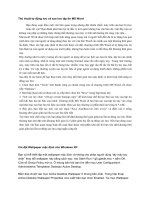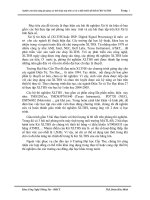PDF final qiz3 OODA và UML
Bạn đang xem bản rút gọn của tài liệu. Xem và tải ngay bản đầy đủ của tài liệu tại đây (656.36 KB, 77 trang )
Part 1 of 2 Question 1 of 20
0.0/ 5.0 Points
Consider the following situation:
a company realizes projects; each project is executed by a team of employees.
Which would be a suitable conceptual UML diagram?
A.
B.
C.
35.0/ 50.0 Points
D.
Question 2 of 20
0.0/ 5.0 Points
Which of the following best describes multiple inheritance?
A. Multiple inheritance occurs when a subclass inherits characteristics from more than
one level of superclass.
B. Multiple inheritance occurs when a subclass is removed from one generalization
hierarchy and added to another.
C. multiple inheritance occurs when a subclass inherits from more than one
generalization hierarchy.
Question 3 of 20
5.0/ 5.0 Points
How do abstract and concrete classes differ from each other?
A. Abstract classes represent intangible concepts in the application domain, whereas
concrete classes represent physical things.
B. Abstract classes are superclasses, whereas concrete classes are subclasses.
C. Abstract classes have no instances, whereas concrete classes have instances.
Question 4 of 20
5.0/ 5.0 Points
Which of these activities COULD occur simultaneously?
A. a22 and a77
B. a44, a33 and a22
C. a44 and a66
D. a77 and a66
Question 5 of 20
5.0/ 5.0 Points
Which of the following statement best describes what a class diagram can include?
A. Only classes
B. Classes and their relationship
C. Class, Instance and their relationship
D. None of these answers
Question 6 of 20
5.0/ 5.0 Points
Which of these are characteristics of a good design?
A. Exhibits strong coupling between its modules
B. Includes test cases for all components
C. Easy to implement
D. Provides a complete picture of the software
Question 7 of 20
5.0/ 5.0 Points
Which of the following best describes how composition differs from aggregation?
A. A part cannot be removed from a composition, whereas a part can be removed from an
aggregation.
B. A part that belongs to a composition cannot have associations with any other classes,
whereas a part that belongs to an aggregation can have associations with other classes.
C. A part can belong to only one composition, whereas a part can belong to more than
one aggregation.
Question 8 of 20
0.0/ 5.0 Points
If you want to plan project activities such as developing new functionalities or test cases, which
of the following OOAD artifacts is the most useful?
A. Domain model
B. Sequence diagrams
C. Use cases
D. Package diagrams
Question 9 of 20
5.0/ 5.0 Points
Which of the following is not a reason for modelling objects?
A. To understand an aspect of the application domain.
B. To separate data from process.
C. To produce a design for part of a software system.
Question 10 of 20
5.0/ 5.0 Points
OMT contains which of following model?
A. Class Model
B. Functional Model
C. Dynamic Model
D. All of these
Part 2 of 2 - Part 2
Question 11 of 20
5.0/ 5.0 Points
Which of following can be a user of a use case diagram?
A. Client
B. Administrator
C. Librarian
D. All of these
Question 12 of 20
5.0/ 5.0 Points
What is a class diagram?
35.0/ 50.0 Points
A. A diagram what describes structure of an object type with their attributes and methods
B. A diagram that show iteration between actor and their behavior in the system
C. A diagram that shows the system's classes, their attributes and behaviors, and the
relationships between the classes
D. A diagram that show iteration between objects in the systems
Question 13 of 20
5.0/ 5.0 Points
When a method in class A calls a method in class B. Which relationship between these 2 classes?
A. Composition
B. Dependency
C. Generalization
D. Aggregation
Question 14 of 20
0.0/ 5.0 Points
Use case relationship is which of following
A. Include, Extend, Specialization
B. Include, Extend, Generalization
C. Include, Extend, Specialization, Generalization
D. Include, Extend, Specialization, Generalization, Inheritance
Question 15 of 20
0.0/ 5.0 Points
Which diagram isn't behavioral diagram?
A. Class diagram
B. Use case diagram
C. Sequence diagram
D. Activity Diagram
Question 16 of 20
5.0/ 5.0 Points
Which of following is true for Activity Diagram?
A. Can be used to depict workflow for a particular business activities
B. Can be use to discover parallel activities
C. Do not tell who does what and are difficult to trace back to object models
D. All the answers
Question 17 of 20
5.0/ 5.0 Points
Which of following is best described Activity Diagram?
A. Activity diagram is used to describe flow of iteration between of objects in the system.
B. Activity Diagram is diagram to show all actors and their behaviours in a system
C. Activity diagram is diagram to show overall flow of iteration between class in the
system.
D. Activity diagrams are graphical representations of workflows of stepwise activities
and actions with support for choice, iteration and concurrency.
Question 18 of 20
5.0/ 5.0 Points
Which of following is true for Composition relationship in Class diagram?
A. Strong type of association
B. One class is the collection of other class
C. Strong life cycle dependency between container objects and contained objects
D. All of these
Question 19 of 20
5.0/ 5.0 Points
Relationship between Actor and Use case is what of following?
A. Association
B. Generalization
C. Extend
D. Specification
Question 20 of 20
0.0/ 5.0 Points
Use case diagram can be used in all of following documents, except
A. DDD
B. URD
C. SRS
D. ADD
Part 1 of 2 Question 1 of 20
0.0/ 5.0 Points
5.0/ 50.0 Points
What is the role of encapsulation in reuse?
A. Encapsulation means that it is not necessary for other developers to know how a
software component works internally.
B. Encapsulation means that there is no need for software developers to document their
work.
C. Encapsulation means that software components can work more efficiently.
Question 2 of 20
0.0/ 5.0 Points
Which of the following best describes multiple inheritance?
A. Multiple inheritance occurs when a subclass inherits characteristics from more than
one level of superclass.
B. Multiple inheritance occurs when a subclass is removed from one generalization
hierarchy and added to another.
C. multiple inheritance occurs when a subclass inherits from more than one
generalization hierarchy.
Question 3 of 20
0.0/ 5.0 Points
Consider the following situation:
a company realizes projects; each project is executed by a team of employees.
Which would be a suitable conceptual UML diagram?
A.
B.
C.
D.
Question 4 of 20
0.0/ 5.0 Points
Which design model elements are used to depict a model of information represented from the
user's view?
A. Architectural design elements
B. Component-level design elements
C. View history data
D. Data design elements
Question 5 of 20
0.0/ 5.0 Points
Which of the following is not a reason for modelling objects?
A. To understand an aspect of the application domain.
B. To separate data from process.
C. To produce a design for part of a software system.
Question 6 of 20
0.0/ 5.0 Points
Which of following is true about OMT?
A. OMT has five phases:
- Analysis
- System Design
- Object Design
- Implementation
- Testing
B. OMT has three phases:
- Analysis
- System Design
- Object Design
C. OMT has four phases:
- Analysis
- System Design
- Object Design
- Implementation
D. OMT has two phases:
- Analysis
- System Design
Question 7 of 20
5.0/ 5.0 Points
Which of these activities COULD occur simultaneously?
A. a22 and a77
B. a44, a33 and a22
C. a44 and a66
D. a77 and a66
Question 8 of 20
0.0/ 5.0 Points
Which of the following best describes how composition differs from aggregation?
A. A part cannot be removed from a composition, whereas a part can be removed from an
aggregation.
B. A part that belongs to a composition cannot have associations with any other classes,
whereas a part that belongs to an aggregation can have associations with other classes.
C. A part can belong to only one composition, whereas a part can belong to more than
one aggregation.
Question 9 of 20
0.0/ 5.0 Points
Which of the following statement best describes what a class diagram can include?
A. Only classes
B. Classes and their relationship
C. Class, Instance and their relationship
D. None of these answers
Question 10 of 20
0.0/ 5.0 Points
Which of these are characteristics of a good design?
A. Exhibits strong coupling between its modules
B. Includes test cases for all components
C. Easy to implement
D. Provides a complete picture of the software
Part 2 of 2 - Part 2
Question 11 of 20
0.0/ 5.0 Points
Use case diagram contains all following factors except
A. Action
B. User
C. Relationship
10.0/ 50.0 Points
D. Use case2
Question 12 of 20
0.0/ 5.0 Points
Bi-directional association relationship of the 2 classes in Class diagram is which of meaning?
A. Only one class is aware of the other and their relationship
B. None of class is aware of the other and their relationship
C. Both classes are aware of each other and their relationship
D. All of These
Question 13 of 20
0.0/ 5.0 Points
Which shape represents start and end of concurrent activities?
A. Rounded rectangle
B. Diamond
C. Bar
D. Encircle black circle
Question 14 of 20
5.0/ 5.0 Points
A. Aggregation
B. Association
C. Composition
D. Generalization
Question 15 of 20
0.0/ 5.0 Points
Which factor is used to describe option in sequence diagram
A. alt
B. pal
C. loop
D. if
Question 16 of 20
0.0/ 5.0 Points
Actor relationship in Use case diagram is what of following?
A. Association
B. Specification
C. Generalization
D. Extend
Question 17 of 20
0.0/ 5.0 Points
Which of following is true for Activity Diagram?
A. Can be used to depict workflow for a particular business activities
B. Can be use to discover parallel activities
C. Do not tell who does what and are difficult to trace back to object models
D. All the answers
Question 18 of 20
5.0/ 5.0 Points
Which of following are true about sequence diagram?
A. A sequence diagram is an interaction diagram that shows how processes operate with
one another and in what order
B. A sequence diagram captures the behavior of a single scenario
C. Sequence diagram emphasis on time sequence of messages
D. All of these
Question 19 of 20
0.0/ 5.0 Points
When would we use a use case diagram?
A. To show iteration between many objects in the system
B. To show relationship between objects
C. To show flow of data in the system
D. To show iteration between a use and a system
Question 20 of 20
0.0/ 5.0 Points
Which factor must exist in a sequence diagram?
A. Found Message
B. Self-Call message
C. Return message
D. Asynchronous Message









